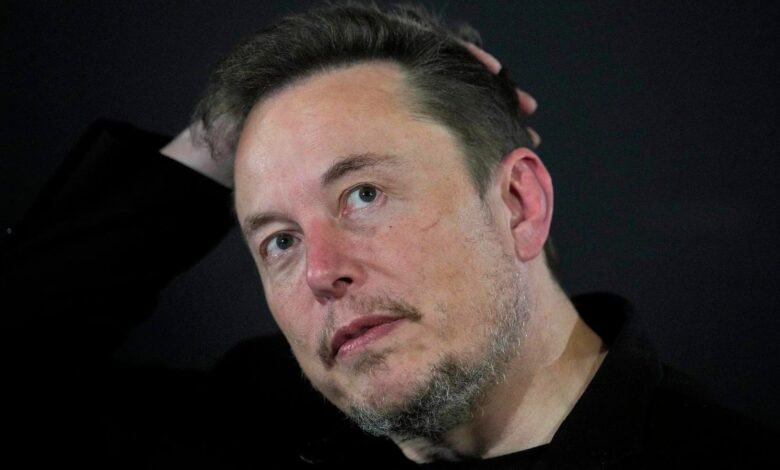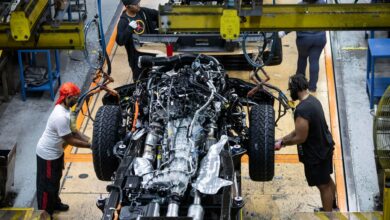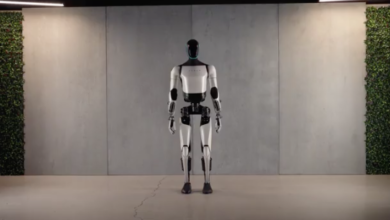Musk Says Tesla’s Optimus Robot Could Launch Next Year—Here’s What Experts Think

Topline
Tesla could start selling its humanoid Optimus robot by the end of next year and one day will rake in more cash from robots than cars, CEO Elon Musk told investors on Tuesday, another ambitious claim from the billionaire that experts said might just be within the realm of possibility—though is highly unlikely to make the carmaker any money in the near future.
Elon Musk hyped Tesla’s Optimus robot after an earnings report on Tuesday.
Key Facts
Optimus, Tesla’s still-in-development humanoid robot, will be able to perform useful tasks in the factory by the end of the year and could reach the market by the end of 2025, Musk told investors after a disappointing earnings report on Tuesday.
Musk, who has a history of making bold claims about his companies that fail to materialize, said he thinks Tesla is the “best positioned of any humanoid robot maker” to produce the bots at scale, adding that they could become the company’s most valuable asset and “more valuable than everything else combined” as there is “no meaningful limit to the size of the economy.”
Animesh Garg, assistant professor of AI robotics at the Georgia Institute of Technology, told Forbes Musk’s timeline is “aggressive” but “realistic from a pure release perspective,” but said the question will be “how useful are the skills that ship out of the box,” particularly when it comes to breadth, generalizability and robustness.
To launch, Garg said he would expect Tesla to have a humanoid platform with limbs, though it’s “unclear how robust and useful” the hands will be, but would be surprised if Optimus could perform tasks beyond competent locomotion and skills like picking up objects that aren’t complicated to grasp, with other features like interacting with objects like windows and doors to possibly follow a year or two later.
Jonathan Aitken, a roboticist at the University of Sheffield in the U.K., agreed Musk’s “timeline would be very challenging” and described 2025 as “ambitious but not out of the question,” saying that a lot depends on “the details of exactly what” Musk is suggesting for its applications.
Christian Hubicki, a robotics professor at Florida State University, said he “wouldn’t be shocked to see some carefully prepared video demos of an Optimus doing some nominal tasks in a factory” by the end of the year but warned it will be “incredibly difficult” to get the bots into the hands of customers who will find them useful in that time.
What We Don’t Know
Hubicki said there are several unknowns surrounding the humanoid robots of Tesla and its competitors like Boston Dynamics and Figure AI that are critical to evaluating their potential for use in the real world outside of glitzy, carefully staged demo videos. Foremost among these is reliability, he said, adding that “the only useful robot is a reliable robot.” Hubicki said this “is a problem for humanoids,” where control is still in the laboratory phase and hardware is fragile. “Will they work 90% of the time? 99%? How many 9’s are enough before they’re more useful in your production line than they are a hassle to fix and babysit? Those are the numbers I’d want to know from a humanoids company.”
What’s The Point Of Humanoid Robots?
Most of the built world is designed for humans and humanoid robots, by design, are well suited to this. While work environments and tasks can be challenging for robots with wheels or other designs to navigate, a humanoid could feasibly thrive and undertake kinds of work that are otherwise limited to humans or very specific machinery. The design imposes a number of formidable technical challenges for both hardware and software, including tasks most humans take for granted like movement and grasping objects. The current boom in AI is helping to drive the field forward, Aitken said, as generalizability is crucial to making humanoids viable tools. “We can’t program a robot to pick up 1000 different objects by programming a process for each one individually,” he explained
What To Watch For
It’s tough to imagine Musk’s claim that Optimus will one day overshadow Tesla’s other products will be realized at any point in the near future, robotics experts told Forbes, particularly its cars. Garg said humanoids are “unlikely to be cashflow positive anytime soon” and despite the hype, they lack a convincing use case that other emerging technologies like driverless cars have. They “will not likely come close to the car business in terms of revenue” for the next decade, he said. Aitken told Forbes “it’s hard to see a humanoid competing seriously with the large industrial players in the sector” and questions whether they’d be able to do the kinds of “high-value, dull, dirty and dangerous” work that would motivate a company to invest. Hubicki said he “would not bet on that market approaching automotives for the foreseeable future.” While humanoid bots have “progressed impressively” in recent years, he said they lack a compelling use case suggesting “a massive market is imminent” and at the moment remain “a complicated technology for completing tasks we can already do better.”
Chief Critic
Analyst Gordon Johnson, of GLJ research, said Musk’s claims were “absurd” and dismissed his year-end 2025 target for Optimus as “utter nonsense and borderline investor fraud.” Johnson said companies that have worked on humanoids for decades haven’t got anywhere close to “where Musk is claiming he will be by the end of 2025.” Optimus is a “pipe dream stock pump,” Johnson said. “There is no product.”
Forbes Valuation
Musk is worth an estimated $191.6 billion. He is the third richest person on the planet, after LVMH’s Bernard Arnault and Amazon founder Jeff Bezos.
Big Number
$6 billion. That’s how much Goldman Sachs’ analysts predict the global market for humanoid robots could reach in the next 10 to 15 years. According to research and analysis company GlobalData, the broader robotics market will be worth $218 billion by 2030.



